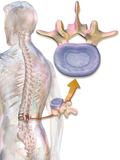Intervertebral disc
Intervertebral disc is a fibrocartilaginous structure found between the vertebrae of the spine. It acts as a shock absorber and allows for movement in the spine. The intervertebral disc is composed of two parts: the outer annulus fibrosus and the inner nucleus pulposus.
Structure[edit]
The annulus fibrosus is the outer part of the intervertebral disc. It is composed of several layers of fibrocartilage. The annulus fibrosus provides strength and flexibility to the disc.
The nucleus pulposus is the inner part of the intervertebral disc. It is a gel-like substance that provides cushioning and shock absorption. The nucleus pulposus is composed of water, collagen, and proteoglycans.
Function[edit]
The intervertebral disc has several important functions. It acts as a shock absorber, absorbing the impact of the body's movements. It also allows for movement in the spine, including bending and twisting.
Diseases and Disorders[edit]
There are several diseases and disorders that can affect the intervertebral disc. These include:
- Disc herniation: This occurs when the nucleus pulposus pushes out through a tear in the annulus fibrosus. This can cause pain, numbness, or weakness in the area of the body served by the affected nerves.
- Degenerative disc disease: This is a condition in which the intervertebral discs break down over time, often due to aging. This can lead to pain and reduced function.
- Discitis: This is an infection in the intervertebral disc, often caused by bacteria or fungi.
Treatment[edit]
Treatment for intervertebral disc disorders depends on the specific condition and its severity. Options may include physical therapy, medication, and in some cases, surgery.
See Also[edit]
|
|
|
-
Intervertebral disc
-
Cervical vertebra
-
Disc herniation
-
Degenerative disc disease
-
Scoliosis intervertebral disc
-
Annulus fibrosus
-
Vertebra
-
Gray's Anatomy illustration 302
-
Gray's Anatomy illustration 308
-
Gray's Anatomy illustration 312
-
Intervertebral disc
-
Intervertebral disc
Ad. Transform your life with W8MD's Budget GLP-1 injections from $75


W8MD offers a medical weight loss program to lose weight in Philadelphia. Our physician-supervised medical weight loss provides:
- Weight loss injections in NYC (generic and brand names):
- Zepbound / Mounjaro, Wegovy / Ozempic, Saxenda
- Most insurances accepted or discounted self-pay rates. We will obtain insurance prior authorizations if needed.
- Generic GLP1 weight loss injections from $75 for the starting dose.
- Also offer prescription weight loss medications including Phentermine, Qsymia, Diethylpropion, Contrave etc.
NYC weight loss doctor appointmentsNYC weight loss doctor appointments
Start your NYC weight loss journey today at our NYC medical weight loss and Philadelphia medical weight loss clinics.
- Call 718-946-5500 to lose weight in NYC or for medical weight loss in Philadelphia 215-676-2334.
- Tags:NYC medical weight loss, Philadelphia lose weight Zepbound NYC, Budget GLP1 weight loss injections, Wegovy Philadelphia, Wegovy NYC, Philadelphia medical weight loss, Brookly weight loss and Wegovy NYC
|
WikiMD's Wellness Encyclopedia |
| Let Food Be Thy Medicine Medicine Thy Food - Hippocrates |
Medical Disclaimer: WikiMD is not a substitute for professional medical advice. The information on WikiMD is provided as an information resource only, may be incorrect, outdated or misleading, and is not to be used or relied on for any diagnostic or treatment purposes. Please consult your health care provider before making any healthcare decisions or for guidance about a specific medical condition. WikiMD expressly disclaims responsibility, and shall have no liability, for any damages, loss, injury, or liability whatsoever suffered as a result of your reliance on the information contained in this site. By visiting this site you agree to the foregoing terms and conditions, which may from time to time be changed or supplemented by WikiMD. If you do not agree to the foregoing terms and conditions, you should not enter or use this site. See full disclaimer.
Credits:Most images are courtesy of Wikimedia commons, and templates, categories Wikipedia, licensed under CC BY SA or similar.
Translate this page: - East Asian
中文,
日本,
한국어,
South Asian
हिन्दी,
தமிழ்,
తెలుగు,
Urdu,
ಕನ್ನಡ,
Southeast Asian
Indonesian,
Vietnamese,
Thai,
မြန်မာဘာသာ,
বাংলা
European
español,
Deutsch,
français,
Greek,
português do Brasil,
polski,
română,
русский,
Nederlands,
norsk,
svenska,
suomi,
Italian
Middle Eastern & African
عربى,
Turkish,
Persian,
Hebrew,
Afrikaans,
isiZulu,
Kiswahili,
Other
Bulgarian,
Hungarian,
Czech,
Swedish,
മലയാളം,
मराठी,
ਪੰਜਾਬੀ,
ગુજરાતી,
Portuguese,
Ukrainian














